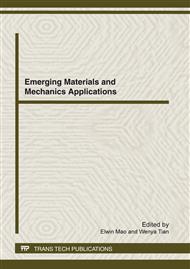p.622
p.627
p.635
p.640
p.644
p.649
p.653
p.658
p.663
Rheological Study on of PBT with High Melt Flow Index
Abstract:
Melt-blown generated PBT nonwoven fabrics usually have small fibril diameter, high flexibility, well heat and oil resistance. Therefore, they would have promising application such as vehicle filtering media. The rheological behavior of PBT with High Melt Flow Index for Melt-blown is investigated in this paper. It is a direction of the technology design and fabrication parameters .The relation of apparent viscosity and shear rate is analyzed, as well as flow activation energy and Non-Newtonian indexes. The results suggest that PBT with High Melt Flow Index is Non-Newtonian fluid. Apparent viscosity and flow activation energy show gradually decrease with increasing shear rate, exhibiting typical shear-thinning behavior.
Info:
Periodical:
Pages:
644-648
Citation:
Online since:
March 2012
Authors:
Keywords:
Price:
Сopyright:
© 2012 Trans Tech Publications Ltd. All Rights Reserved
Share:
Citation:


